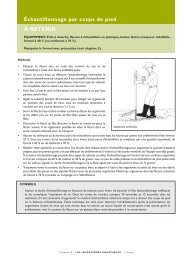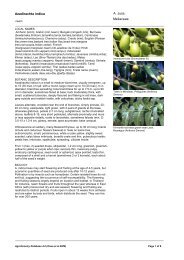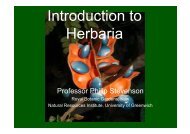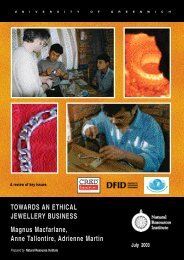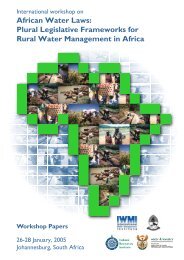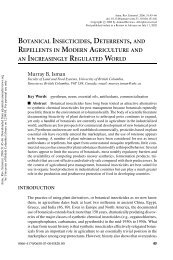Meteorological methods: temperature; humidity; rainfall; wind speed
Meteorological methods: temperature; humidity; rainfall; wind speed
Meteorological methods: temperature; humidity; rainfall; wind speed
Create successful ePaper yourself
Turn your PDF publications into a flip-book with our unique Google optimized e-Paper software.
Classification of aquatic substrates<br />
DON’T FORGET<br />
EQUIPMENT: Cylinder sampler; scoop; set of sieves; bucket; spring balance; notebook;<br />
pencil.<br />
The substrates of river and stream beds range from fine particles of clay to boulders.<br />
Substrate analysis can be rapid and crude or lengthy but more exacting depending on the<br />
goal. For the siting of sampling stations for monitoring work, a rapid analysis should suffice.<br />
This is normally done by eye in the first instance.The test of reasonably matched sites is to<br />
find reasonably matched biota.<br />
RAPID ANALYSIS<br />
Method<br />
• If the water is clear or very shallow, just note the main characteristics of the sampling station, e.g.<br />
percentage bedrock or pebble, gravel or sand, silt and clay.<br />
• Water flowing over solid rock just needs noting: as very few invertebrates can inhabit this substrate<br />
– algae and vegetation are more successful – the medium does not lend itself to meaningful analyses<br />
of populations.<br />
PARTICLE SIZE ANALYSIS<br />
Method<br />
• Examine the substrate type in a delimited area – perhaps 1–5 m 2 . Estimate the size range and<br />
number of rocks.<br />
• In substrates comprising smaller categories of material, use a cylinder sampler (see method sheet<br />
from chapter 9), turning the meshed opening away from the flow, lift the pebbles out and measure<br />
their lengths.<br />
• Using a trowel or tin can, scoop up the underlying gravel, sand and sediment and place in a sieve<br />
series, shaking them in a bucket of water or nearby pool, to separate the particulate sizes.<br />
• Let the materials drain for 5 min and weigh each sieve separately on a spring balance to estimate the<br />
material retained – subtracting the sieve weight.<br />
• Repeat two more times in the same delimited area to characterize and then tabulate the result as,<br />
for example, lengths of largest parameter (stones/pebbles) or weights of materials from sieves.<br />
Substrate categories<br />
N a m e S i ze range Lengths/weight<br />
Clay 256 mm<br />
OTHER CONSIDERATIONS<br />
Substrate type at Site 12<br />
% by weight<br />
A sieve series with mesh apertures of 16 mm, 2 mm, 500 µm, 250 µm, and 100 µm should suffice.<br />
Narrower aperture sieves quickly clog and so silt/clay analyses are normally determined gravimetrically<br />
in a laboratory.<br />
Chapter 5 E N V I R O N M E N TA L PA R A M E T E R S I. Grant<br />
Silt<br />
Fine sand<br />
Medium sand<br />
Coarse sand<br />
Gravel



